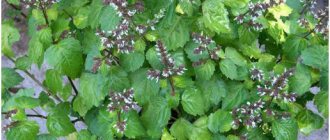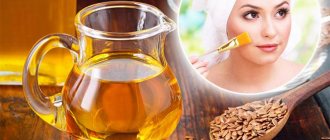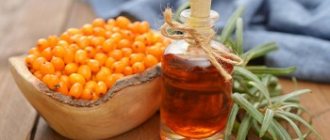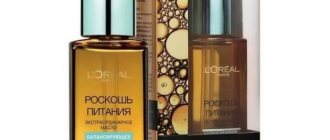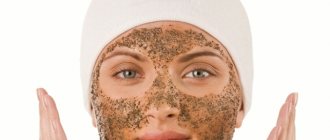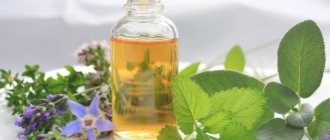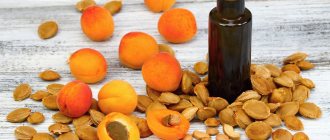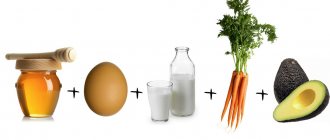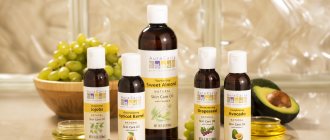Properties and composition
Unrefined pumpkin oil for the face is extracted from the seeds by cold pressing and does not contain any harmful elements; it is a completely natural and extremely healthy product.
It contains a lot of vitamins A and E, which are necessary for youthful facial skin. There are also polyunsaturated fatty acids, selenium, zinc, rutin, nicotinic acid, and other components that any cosmetologist recognizes as irreplaceable. Beneficial features:
- Nicotinic acid causes blood to circulate more actively, as a result of which skin cells are better supplied with nutrients and oxygen.
- Rutin helps fight rashes and blackheads.
- Selenium slows down the aging process and increases skin resistance to adverse external conditions.
- Zinc oxide absorbs and reflects ultraviolet radiation, helping to resist the damaging effects of sunlight.
Indications:
- increased skin sensitivity;
- tendency to inflammation and irritation;
- the first signs of withering, fine wrinkles;
- chapping, peeling, rough skin.
Contraindications – individual intolerance.
How to use internally
Pumpkin seed extract is often used in folk medicine to treat diseases of organs and systems, dermatological ailments, and strengthen the immune system. The possibility of using the drug, the absence of contraindications and dosage should be checked with your doctor. Self-medication can negatively affect your health!
To treat diseases of the kidneys, liver, heartburn, gastritis, cholestasis, enterocolitis, it is enough to take 1 tsp orally. pumpkin oil 3-4 times a day. The extract is consumed half an hour to an hour before meals, without drinking water.
To improve immunity, for preventive purposes it is recommended to consume the oil 2 times a day for a month. Longer use (up to 2 months) is prescribed for the prevention of atherosclerosis.
The plant product is also useful for dressing salads and main courses. The extract will give the dish a pleasant nutty aroma and fill it with vitamins and nutrients.
Pumpkin extract should not be used orally for such disorders and diseases as:
- diabetes;
- cholelithiasis;
- diarrhea;
- individual intolerance.
It is unacceptable to use a product that has expired, is counterfeit, or is of poor quality and has undergone heat treatment.
You should not eat rye bread or fresh juices with pumpkin oil. In other words, it is better to avoid foods that are high in acid.
Note! Using the oil internally may cause stool thinning. Upon completion of therapy, the laxative effect will disappear.
Benefits and harms
Pumpkin oil is recognized in cosmetology as bringing great benefits to the skin of the face and the whole body:
- softens and nourishes;
- Over time, with constant use, it makes the skin elastic and firm;
- resists inflammatory processes, treats irritations;
- inhibits the aging process and has a regenerating effect;
- heals cracks on the lips;
- normalizes the functioning of the sebaceous glands;
- protects against ultraviolet rays in sunny weather.
Pumpkin oil can only be harmful to people with certain diseases when consumed orally. And for external use - only in case of individual intolerance, which is extremely rare. If you ate pumpkin seeds before and everything was fine, then there will be no problems with the oil.
Pumpkin oil for face
In order for the skin to gain vitality, become moisturized and soften, pumpkin oil for the face should be used daily. To do this, apply a thin layer of undiluted liquid to the entire skin. Wash off after 30 minutes. There are many options for using pumpkin seed oil in cosmetic recipes. It is enough to add 5-6 drops to ready-made creams, masks, tonics.
There is a recipe for a mask: cut the pumpkin pulp into cubes, boil in milk for 30 minutes. Add a spoonful of olive oil and pumpkin seeds to the puree. Leave for 15 minutes, apply for 30 minutes.
And in the summer, when the sun’s rays negatively affect the skin, pumpkin oil will come to the rescue again. When tanning, it should be applied to the skin, which will minimize the likelihood of burns, blemishes and pigmentation. This use is indicated for wounds, bruises and inflammation.
Methods of application
The easiest way is to add pumpkin oil to the creams you usually use. Many people do this, this is a common practice, but I would recommend thinking about this. Cheap store-bought cosmetics are full of preservatives, parabens and other dangerous chemicals. A few drops of oil will not improve the situation at all. Expensive creams from well-known brands have a balanced, repeatedly tested composition and perfectly perform their function without “additives”.
Therefore, it makes much more sense to make homemade cosmetics using natural ingredients using pumpkin oil. It’s cheap, all the components are easily accessible, and you are completely confident in the safety of the composition, since you made everything yourself from fresh products and used it immediately, without putting it on the back burner.
Some even try to make pumpkin oil themselves, at home, to be sure of its environmental friendliness. I think this is unnecessary. In most cases, store-bought cold-pressed oil is a healthy product without harmful impurities; there is no point in wasting time trying to get it yourself.
The oil should not be heated. When used on the skin in this form, it will not cause any harm, but all useful components and vitamins will be destroyed during heat treatment, so there will be no benefit from it.
For face
On dry skin with the first signs of wilting, pumpkin oil can be applied as a tonic - in its pure form. To do this, I recommend using cotton pads or doing everything with your hands. First of all, you need to wash your face, cleanse your skin, then apply the oil in a thin layer. You can remove the excess in about forty minutes using a regular paper towel. You are allowed to do this every day.
If your skin reacts poorly to decorative cosmetics, you can do the following. Take a piece of clean cotton cloth and soak it in hot water. Then squeeze and, without allowing to cool, soak in pumpkin oil. Immediately apply this textile mask to your face, and add a warm towel on top of it. Lie like this for half an hour, relax and rest. There is no need to repeat this procedure often; twice a month is enough.
If your face is peeling, there are areas of irritation, small wounds or pimples, you can specifically lubricate these problem areas with pumpkin oil.
For the skin around the eyes
The product can be used all over the face, including the delicate and sensitive area around the eyes. Compresses with pumpkin oil help get rid of swelling and make fine wrinkles in this area less noticeable. But do them 1.5-2 hours before bedtime.
A little history
The benefits and value of pumpkin oil were sung by the Persian medieval scientist and physician Avicenna (Abu Ali ibn Sina), using it as a medicine for many diseases. And pumpkin seeds are still found in the graves of Peruvian Indians.
The first mention of pumpkin seed oil in later times was in 1739. A separate book on pumpkin seeds states that they are used to make a sweet oil that can make the skin soft and tender.
Later, in 1773, by order of Maria Theresa (Empress of Hungary, Austria and Bohemia), pumpkin oil began to be used not only for culinary purposes, but also as a component of medical plasters and medicinal ointments.
In the first half of the 18th century, pumpkin extract was also used in warfare as a lubricant for cart components due to its high content of saturated fatty acids. This idea still remains relevant and is used as an important component of lubricating oils.
To prepare the popular remedy, “pressing trees” were used. Over the years, technology has improved and trees have replaced hydraulic presses.
The leader in the production of nutritious oil today remains the Austrian province of Stria. It produces about 2,000 tons of valuable product every year.
It is worth noting that in medieval Europe, vegetable oil was quite expensive; purchasing 200 g of extract was on par with the cost of a massive gold ring. And at the beginning of the last century, the cost of 1 liter of plant product was about 90 pounds sterling, perhaps it was after this that it began to be called “green gold.”
Mask recipes
There is a suitable recipe for every skin problem. The basic rule for everyone is that you need to apply the mask to clean skin. Use your regular cleanser, and for a better effect, you can use a pore enlargement gel afterwards or simply steam your skin with a hot towel. Finally, any mask is washed off immediately with warm (not hot) water, and then again with cold water to close the pores.
For tired skin
If your skin looks tired and dull, make a nourishing mask of pureed beans, pumpkin and walnut oils and fresh lemon juice. You need one tablespoon of all components. Mix them until smooth by hand or using a mixer.
You can apply the mass not only to the face, but also to the neck and décolleté - the effect will be wonderful. You can keep it for up to half an hour.
For different types
An egg mask is good for all skin types except oily skin. It takes time to prepare, so it is better to do it on the weekend or in the evening. Take ten grams of gelatin and soak in cold water (50 ml), leave for an hour. During this time, it will swell well and you can place it in a container in a water bath so that it completely dissolves. The gelatin base should cool to room temperature, after which you can add chicken yolk and a tablespoon of pumpkin oil.
All this needs to be whipped into foam; you can’t do it by hand, you’ll need a mixer. The finished mass is applied to the face and neck and left for 20 minutes. The product has an anti-aging effect, makes the skin softer and more elastic and stimulates cell regeneration.
For fatty
A honey-oatmeal mask will help oily skin. You need a tablespoon of both ingredients, and 7 drops of pumpkin oil. You will need to grind the oatmeal in a coffee grinder or use ready-made flour; Honey, if it has frozen, heat it in a water bath until it becomes liquid again. All this is thoroughly mixed and applied to the face for about twenty minutes, no more.
For dry
There is a special mask for dry skin. You will need a tablespoon of natural farm sour cream, three tablespoons of mashed potatoes, one raw yolk and a spoon of pumpkin oil. All components are poured into a warm (but not hot) puree and mixed.
The mixture should form a nice dense layer and not be too runny. Like the previous remedy, it is kept for 20 minutes. You can do it up to two times a week.
User reviews
Pumpkin seed oil is considered a delicious medicine. It is used internally and externally, without fear of possible side effects and complications. The following user talks about such an application.
The benefits and naturalness of vegetable oil are also discussed in the following review.
Pumpkin seed cosmetic oil is considered an excellent natural moisturizer. The next participant talks about this. In addition, the product can be used during pregnancy.
You will read about the effectiveness of the extract in skin restoration
Pumpkin seed oil is an opportunity to look perfect without resorting to plastic surgery. In addition, the aromatic product can be used not only externally, but also taken as food. This medicine will bring pleasure not only to you, but also to your loved ones!
Efficiency and result
Pumpkin oil simply cannot be ineffective, because it contains many substances that are beneficial and necessary for the skin. For example, retinol (vitamin A), a wonderful antioxidant that is used in professional creams to maintain skin elasticity and slow down the aging process. It contains tocopherol (vitamin E), which also has a rejuvenating effect, and ascorbic acid, which stimulates collagen production.
The results after using the product are wonderful. The skin is noticeably rejuvenated, all minor damage heals, the tone is evened out, and the complexion becomes better.
All my clients who tried pumpkin oil themselves left good reviews about this product. Those with dry skin prone to flaking speak especially enthusiastically about the product. All unpleasant effects disappear for them. If you use masks regularly, your face becomes moisturized and rough areas soften. Many also note that age spots fade and disappear.
Indications
Based on the list of beneficial qualities of pumpkin oil, it is easy to understand what niche it occupies in dermatology and cosmetology. Among the indications for using such a product it is worth mentioning:
- Acne.
- Dermatitis and eczema.
- Cuts and burns.
- Trophic ulcers.
- Dermatomycoses.
- Insect bites.
- Hyperkeratosis.
- Seborrhea.
In addition to obvious diseases, the oil helps to cope with various aesthetic defects. It is used for excessive dryness of the epithelium and peeling, spider veins (rosacea), premature aging of the skin (wrinkles, sagging). Prevention of sunburn and photoaging is another aspect of the use of this product. The oil is also good for hair, as it prevents hair loss and makes it stronger.

